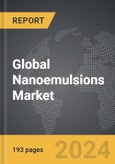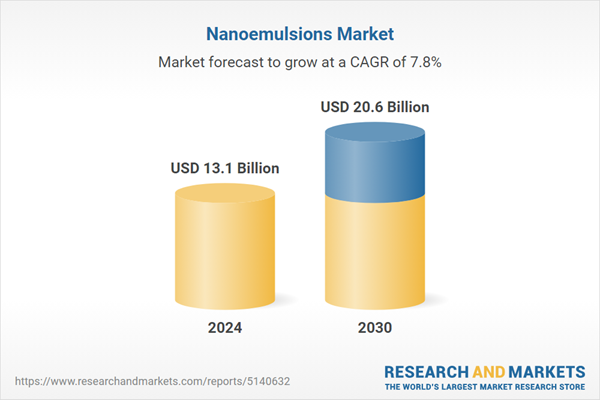Global Nanoemulsions Market - Key Trends & Drivers Summarized
What Are Nanoemulsions, and Why Are They So Crucial in Modern Applications?
Nanoemulsions are submicron-sized emulsions with droplet sizes typically ranging from 20 to 200 nanometers. These emulsions consist of two immiscible liquids, where one liquid is dispersed in the other, stabilized by surfactants or emulsifiers. They offer enhanced stability, improved bioavailability, and high solubility for active ingredients, making them ideal for a variety of industries, including pharmaceuticals, cosmetics, food and beverages, and agrochemicals. Nanoemulsions are commonly used for delivering hydrophobic drugs, cosmetic ingredients, and nutrients, offering efficient encapsulation and sustained release properties.The importance of nanoemulsions lies in their ability to enhance the effectiveness of formulations across diverse applications. In pharmaceuticals, they improve drug delivery by increasing the solubility and absorption of poorly water-soluble drugs, thereby enhancing therapeutic outcomes. In cosmetics, nanoemulsions are used to improve the penetration of active ingredients into the skin, leading to better product performance. Similarly, in the food and beverage industry, nanoemulsions are utilized to encapsulate flavors, nutrients, and oils, enhancing their stability and bioavailability. As industries seek better ways to deliver active compounds efficiently and consistently, nanoemulsions have become a critical tool for innovation in product development and consumer applications.
How Are Technological Advancements Shaping the Nanoemulsions Market?
Technological advancements have significantly improved the formulation, stability, and scalability of nanoemulsions, driving innovation across various sectors. One of the major developments is the use of high-energy methods, such as high-pressure homogenization, microfluidization, and ultrasonication, to create nanoemulsions with uniform droplet sizes. These techniques provide better control over droplet distribution, resulting in more stable emulsions with improved shelf life. High-pressure homogenization, for instance, involves forcing the emulsion through a narrow gap at high pressure, breaking down droplets into nanometer sizes, which is particularly useful in drug delivery and cosmetics formulations.The development of low-energy emulsification methods has also contributed to the growth of nanoemulsions. Techniques like phase inversion temperature (PIT) and spontaneous emulsification require less energy and can produce nanoemulsions at lower costs. These methods are advantageous for the food and beverage industry, where cost-effectiveness and scalability are essential. Low-energy methods are also more suitable for sensitive compounds, such as vitamins and bioactive compounds, preserving their functionality during the emulsification process.
Advancements in emulsifiers and surfactants have further enhanced the stability and performance of nanoemulsions. Natural emulsifiers, such as proteins, polysaccharides, and phospholipids, have gained popularity due to their biocompatibility and reduced toxicity. The use of bio-based emulsifiers aligns with consumer preferences for clean-label products in food, cosmetics, and personal care. Additionally, the development of smart nanoemulsions that respond to external stimuli like pH, temperature, or light has expanded the functionality of these systems, enabling controlled release and targeted delivery of active ingredients. These innovations not only improve the effectiveness of nanoemulsions but also support broader trends toward safer, more efficient, and sustainable formulations in various industries.
What Are the Emerging Applications of Nanoemulsions Across Different Sectors?
Nanoemulsions are finding expanding applications across diverse sectors, driven by the need for better delivery systems, enhanced bioavailability, and improved stability. In the pharmaceutical sector, nanoemulsions are widely used for oral, topical, and parenteral drug delivery. They enhance the solubility and absorption of poorly water-soluble drugs, leading to increased bioavailability and faster therapeutic action. Nanoemulsions are also used in vaccines and cancer therapies, where they improve the stability of active ingredients and enable targeted delivery, minimizing side effects and enhancing treatment efficacy.In the cosmetics and personal care sector, nanoemulsions are employed in skincare products, hair care formulations, and anti-aging treatments. They enhance the penetration of active ingredients into the skin, resulting in better hydration, improved texture, and increased efficacy of products like serums, moisturizers, and sunscreens. Nanoemulsions offer a non-greasy, lightweight feel, which is desirable in cosmetic formulations, making them popular in high-performance skincare products.
In the food and beverage industry, nanoemulsions are used to encapsulate flavors, vitamins, and nutraceuticals, improving their dispersion, stability, and bioavailability. They enhance the taste, texture, and nutritional value of food products, while also enabling the development of low-fat and low-calorie formulations by increasing the solubility of oils and fats. Nanoemulsions are also used in beverages to stabilize functional ingredients, such as omega-3 fatty acids, antioxidants, and plant extracts, allowing manufacturers to develop healthier, fortified drinks with longer shelf lives.
In the agrochemical sector, nanoemulsions are used to deliver pesticides, herbicides, and fertilizers more effectively. They improve the dispersion and absorption of active ingredients, reducing the required doses and minimizing environmental impact. Nanoemulsions facilitate better adherence to plant surfaces, enhancing the efficacy of crop protection agents and supporting sustainable agricultural practices. The expanding applications of nanoemulsions across these sectors highlight their critical role in enhancing product performance, safety, and consumer satisfaction.
What Drives Growth in the Nanoemulsions Market?
The growth in the nanoemulsions market is driven by several factors, including increasing demand for improved drug delivery systems, rising consumer interest in functional foods and cosmetics, and advancements in emulsification technologies. One of the primary growth drivers is the growing need for effective drug delivery systems in the pharmaceutical industry. As the number of poorly water-soluble drugs increases, pharmaceutical companies are seeking advanced formulations that improve solubility, stability, and bioavailability. Nanoemulsions offer a viable solution, enabling faster absorption, targeted delivery, and reduced dosage, which enhance patient outcomes and support pharmaceutical innovation.The rising consumer demand for functional foods, nutraceuticals, and clean-label cosmetics has further fueled the adoption of nanoemulsions. Consumers are increasingly seeking products that offer enhanced nutritional benefits, better skin absorption, and natural ingredients. Nanoemulsions enable manufacturers to deliver active ingredients more effectively, supporting claims of improved performance in functional foods, dietary supplements, and skincare products. This aligns with consumer trends toward health and wellness, driving demand for fortified foods, anti-aging skincare, and plant-based formulations.
Advancements in emulsification technologies and equipment have also contributed to market growth. High-energy methods like high-pressure homogenization and ultrasonication, combined with the development of novel emulsifiers, have improved the stability, scalability, and cost-effectiveness of nanoemulsions. These innovations have made it easier for manufacturers to incorporate nanoemulsions into their product lines, supporting diverse applications across pharmaceuticals, cosmetics, and food processing.
Regulatory approvals and guidelines for nanoemulsions in pharmaceuticals and food products have further supported market growth. As regulatory bodies recognize the safety and efficacy of nanoemulsions, manufacturers have gained confidence in developing and commercializing new products. The increased focus on sustainable and bio-based emulsifiers has also driven demand for eco-friendly nanoemulsion formulations, particularly in clean-label food and cosmetic products.
With ongoing innovations in emulsification methods, ingredient compatibility, and personalized delivery systems, the nanoemulsions market is poised for robust growth. These trends, combined with increasing demand for improved delivery systems, enhanced bioavailability, and sustainable formulations, make nanoemulsions a vital component of modern product development strategies across pharmaceuticals, food and beverages, cosmetics, and agriculture.
Report Scope
The report analyzes the Nanoemulsions market, presented in terms of market value (US$ Thousand). The analysis covers the key segments and geographic regions outlined below.- Segments: Application (Steroids, Anesthetics, NSAIDs, Immunosuppressant, Antiretroviral, Antimicrobials, Vasodilators); Route of Administration (Topical, Oral, Parenteral, Nasal).
- Geographic Regions/Countries:World; United States; Canada; Japan; China; Europe (France; Germany; Italy; United Kingdom; and Rest of Europe); Asia-Pacific; Rest of World.
Key Insights:
- Market Growth: Understand the significant growth trajectory of the Topical Administration segment, which is expected to reach US$4.2 Billion by 2030 with a CAGR of a 7.4%. The Oral Administration segment is also set to grow at 7.9% CAGR over the analysis period.
- Regional Analysis: Gain insights into the U.S. market, valued at $3.6 Billion in 2024, and China, forecasted to grow at an impressive 7.4% CAGR to reach $3.2 Billion by 2030. Discover growth trends in other key regions, including Japan, Canada, Germany, and the Asia-Pacific.
Why You Should Buy This Report:
- Detailed Market Analysis: Access a thorough analysis of the Global Nanoemulsions Market, covering all major geographic regions and market segments.
- Competitive Insights: Get an overview of the competitive landscape, including the market presence of major players across different geographies.
- Future Trends and Drivers: Understand the key trends and drivers shaping the future of the Global Nanoemulsions Market.
- Actionable Insights: Benefit from actionable insights that can help you identify new revenue opportunities and make strategic business decisions.
Key Questions Answered:
- How is the Global Nanoemulsions Market expected to evolve by 2030?
- What are the main drivers and restraints affecting the market?
- Which market segments will grow the most over the forecast period?
- How will market shares for different regions and segments change by 2030?
- Who are the leading players in the market, and what are their prospects?
Report Features:
- Comprehensive Market Data: Independent analysis of annual sales and market forecasts in US$ Million from 2024 to 2030.
- In-Depth Regional Analysis: Detailed insights into key markets, including the U.S., China, Japan, Canada, Europe, Asia-Pacific, Latin America, Middle East, and Africa.
- Company Profiles: Coverage of players such as Ascendia Pharmaceuticals, Covaris, LLC, Creative Biolabs, Genizer LLC, IDEX Material Processing Technologies and more.
- Complimentary Updates: Receive free report updates for one year to keep you informed of the latest market developments.
Some of the 43 companies featured in this Nanoemulsions market report include:
- Ascendia Pharmaceuticals
- Covaris, LLC
- Creative Biolabs
- Genizer LLC
- IDEX Material Processing Technologies
- Industrial Sonomechanics
- LATITUDE Pharmaceuticals Inc.
- Owen Biosciences, Inc
- Qsonica L.L.C
- Taiwan Liposome Company, Ltd.
This edition integrates the latest global trade and economic shifts into comprehensive market analysis. Key updates include:
- Tariff and Trade Impact: Insights into global tariff negotiations across 180+ countries, with analysis of supply chain turbulence, sourcing disruptions, and geographic realignment. Special focus on 2025 as a pivotal year for trade tensions, including updated perspectives on the Trump-era tariffs.
- Adjusted Forecasts and Analytics: Revised global and regional market forecasts through 2030, incorporating tariff effects, economic uncertainty, and structural changes in globalization. Includes historical analysis from 2015 to 2023.
- Strategic Market Dynamics: Evaluation of revised market prospects, regional outlooks, and key economic indicators such as population and urbanization trends.
- Innovation & Technology Trends: Latest developments in product and process innovation, emerging technologies, and key industry drivers shaping the competitive landscape.
- Competitive Intelligence: Updated global market share estimates for 2025, competitive positioning of major players (Strong/Active/Niche/Trivial), and refined focus on leading global brands and core players.
- Expert Insight & Commentary: Strategic analysis from economists, trade experts, and domain specialists to contextualize market shifts and identify emerging opportunities.
Table of Contents
Companies Mentioned (Partial List)
A selection of companies mentioned in this report includes, but is not limited to:
- Ascendia Pharmaceuticals
- Covaris, LLC
- Creative Biolabs
- Genizer LLC
- IDEX Material Processing Technologies
- Industrial Sonomechanics
- LATITUDE Pharmaceuticals Inc.
- Owen Biosciences, Inc
- Qsonica L.L.C
- Taiwan Liposome Company, Ltd.
Table Information
| Report Attribute | Details |
|---|---|
| No. of Pages | 193 |
| Published | December 2025 |
| Forecast Period | 2024 - 2030 |
| Estimated Market Value ( USD | $ 13.1 Billion |
| Forecasted Market Value ( USD | $ 20.6 Billion |
| Compound Annual Growth Rate | 7.8% |
| Regions Covered | Global |









